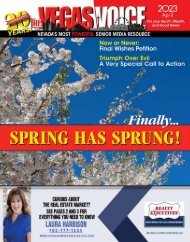Create successful ePaper yourself
Turn your PDF publications into a flip-book with our unique Google optimized e-Paper software.
Summer Heat Gardening
By: Howard Galin / Happy Gardening
Welcome to Summer! For many residents
of Southern Nevada, getting used to this
season’s high temperatures and low humidity can
take some time and effort.
We have in the Las Vegas area two main growing seasons. March
through June, and September to February. July and August are too hot
and dry to permit most non-native vegetation from growing. During
this time non-native plants and delicate native plants can go into a
period of dormancy.
Non-natives, without major gardener intervention, can even die off.
With the proper attention, however, many flowering plants, as well as
fruits and vegetables, will continue to grow. Your goals are to reduce
soil heat and excessive sun damage.
In mid-summer, it is not unusual to find that the rock mulch that
surround your landscaping reaches temperatures in excess of 150F!
This can cause vegetation to literally burn up and die.
In order to mitigate this danger, make sure that rock mulch is pushed
away from plants that are located in direct sunlight for long periods of
time. Surround these plants instead with wood mulch or peat moss.
This will lower ground temperatures by almost 60 degrees as well as
keeping moisture in the soil around the roots.
Plan for the actual location of the plants that make up your
landscaping. Remember that homes are painted light beige; a color
that is meant to reflect heat and sun away from your home.
This reflection will bounce off your outside walls and onto any plants
in close proximity to your home. Indeed, the soil temperatures directly
by your outside walls can average 5-10 degrees higher than soil further
away. Move plants away from your house or consider planting heat/sun
resistant plants such as agave, yucca, cactus and flowering plants like
lantana nearer to your house.
Another way to prevent heat and sun damage is not to water when the
sun is shining. Water droplets act as magnifying glasses that intensify
the sun’s ray onto the leaves, flowers, fruits and vegetables causing
plant damage.
Have any questions? Contact me: Theplantwhisperer28@gmail.com.
Howard Galin, a/k/a: “The Plant Whisperer” is a retired NYC
school administrator, transplanted in Las Vegas who devotes his
time to communicating with and lecturing about our native
plants.
18
July 2020

















